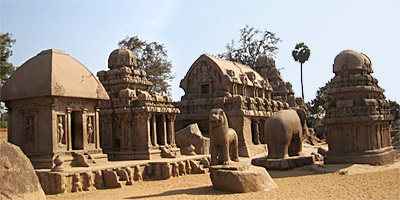The monolithic temples or Rathas are known as the "Seven Pagodas", though now only five exist. These Rathas are named after the five Pandava brothers and their wife Draupadi. These are not really chariots or cars nor have they anything to do with the heroes of the Mahabharat. They are simply temples intended for the worship of Shiva, Durga and some other unknown deities. The Rathas of Mahabalipuram also closely reflect the aesthetic sense of the Pallava rulers. They were in fact the transition between rock-cut temples and free-standing cave temples. The five Rathas of Mahabalipuram are Dharmaraja Ratha, Bhima Ratha, Arjuna Ratha, Draupadi Ratha, Sahadeva Ratha.
 Dharmaraja Ratha: It measures 29 by 27 by 35 feet and is shaped as a pyramid. Narasimha Varman I and is considered the creator of this monument. The figures of Gods and men sculptured in the niches of the first three storeys of this Ratha, and the lonely words inscribed in bold and flowery letters, attract our attention. The first floor of the Ratha contains the familiar Somaskanda group (Shiva with Parvati and Subrahmanya). One special feature about the treatment of the figure of Parvati is that she is looking at Lord Shiva instead of at the spectator as in other similar groups. The external face of the Ratha holds in its rectangular niches images of divinities, some of which are unfinished and some unidentifiable.
Dharmaraja Ratha: It measures 29 by 27 by 35 feet and is shaped as a pyramid. Narasimha Varman I and is considered the creator of this monument. The figures of Gods and men sculptured in the niches of the first three storeys of this Ratha, and the lonely words inscribed in bold and flowery letters, attract our attention. The first floor of the Ratha contains the familiar Somaskanda group (Shiva with Parvati and Subrahmanya). One special feature about the treatment of the figure of Parvati is that she is looking at Lord Shiva instead of at the spectator as in other similar groups. The external face of the Ratha holds in its rectangular niches images of divinities, some of which are unfinished and some unidentifiable.
Bhima Ratha: It measures 48 by 25 by 26 feet and is found north of the Dharmaraja Ratha, with a wagon shaped roof. The upper part of the edifice has almost been completed while the lower part has not been finished. This leads to the conclusion that the architect worked from the above. There are no sculptures or inscriptions on this Ratha.
Arjuna Ratha: This measures 16 by 11 by 14 feet and stands north of Bhima Ratha. It is pyramidal in shape just as the Dharmaraja Ratha. As this could be conveniently used as a shelter house, it has been somewhat damaged through use by vagrants and wayfarers. An attractive feature of this monument is the group of secular sculptures found on it. There are also images of Shiva with his bull, Lord Vishnu, and Indra with his elephant.
Draupadi Ratha: Measuring 14 by 11 by 14 feet, is a plain, tiny-looking hut-like monolith, north of Arjuna Ratha. Above the entrance and the niches on the three walls there are Markara Toranas). The back wall contains a relief of Goddess Durga with attendants and worshippers.
Sohadeva Ratha: The Ratha stands to the south-west of Arjuna Ratha and has the peculiar shape of a horse-shoe at the back. Consequently, the roof has also a semicircular end. But the front of the roof is wagon shaped like Bhima Ratha.
Though all the five Rathas are similar in style, they vary in form. Around the Rathas are grouped some fine monolithic sculptures of animals-lion, bull and elephant. Though these figures cannot be said to have been carved out with extreme skill and dexterity, yet they have their own charm and elegance.











